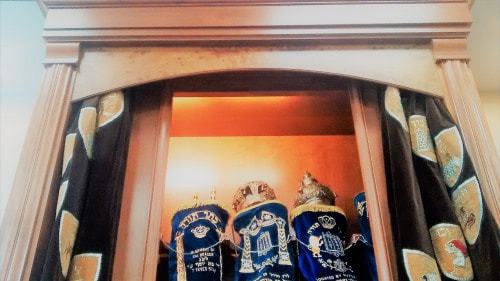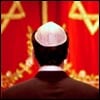The aron kodesh (“holy ark”), where the Torah Scrolls are kept, is situated in the front of the synagogue. In the Sephardic tradition, it is referred to as the heichal (“chamber”). The ark is the holiest place in the synagogue.
The ark is opened only during special prayers and when removing the Torah to read during prayer services. It is customary (but not obligatory) to stand when the ark is opened.
Watch: Opening the Ark.
Since it houses sacred items, the ark itself is considered holy. Thus, an ark may not be modified for non-sacred uses or discarded in a disrespectful manner.
Ark Architecture

In addition to its doors, the ark is often closed off by an ornate curtain called a parochet. It is reminiscent of the curtain that shielded the golden ark that was in the Holy Temple. As it is written, "He brought the ark into the Tabernacle and placed the screening dividing curtain so that it formed a protective covering before the ark."1
In synagogues that are to the west of Jerusalem, the ark is on the eastern wall, so that when we face the ark we are facing the holy city of Jerusalem where the Holy Temple once stood.
Traditionally, arks were built into the eastern wall of the synagogue. However, freestanding arks are also common, especially in Chabad centers, where the sanctuary may also double as an all-purpose community room.
While the ark can be made of any material, the most common seems to be wood.
Often the ark has built-in brackets so that the Torah scrolls can be propped up in an almost upright position.
Writing on the Ark

The aron kodesh and/or the parochet are often decorated with words from scripture or the sages that reflect the sanctity of the synagogue or the specialness of the Torah housed therein.
A common phrase used is the Talmudic adage, “Da lifnei mi atah omed,” “Be aware before whom you stand.” Another is the verse from Psalms, “Torat Hashem temimah,” “The teachings of G‑d are perfect.”
There is much room to decide which verses to display, and synagogues may choose which verses reflect their values or aspirations. It is also common for the names of benefactors or their loved ones to be embossed or embroidered on the ark or the parochet.
During the High Holiday season, the curtain for the ark, the covers of the Torah scrolls, and the cloths covering the amud and the bimah are traditionally exchanged for white ones. White represents purity, forgiveness and a clean slate, all central High Holiday themes.
In many cases, the holy ark sports an image of the two Tablets that bear the Ten Commandments. Other common motifs include lions, Torahs, crowns and other Judaic imagery.








Join the Discussion